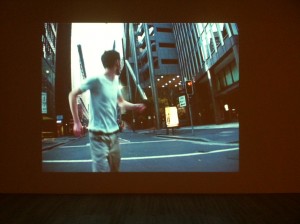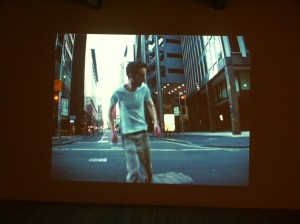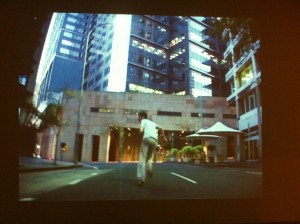TV Moore’s ‘The dead zone’ at AGNSW
In New York in February I saw the exhibition NYC 1993: experimental jet set, trash and no star, which I wrote about briefly for Stamm. Perhaps the most interesting thing for someone from my generation (born 1980) was its attempt to historicise 1993—a ‘period’ from my own lifetime. There was a bank of video monitors on the upper floor that grounded the included artworks through that year’s daily news cycle and emphasised the fact they were made in time, bound by real events from the prosaic to the extraordinary.
Last week in Sydney I saw TV Moore’s The dead zone, a work from 2003—exactly a decade later. Now a decade old itself, I wondered if it too was somehow emblematic of its time. What did 2003 look like in the art world? Was it any different from 2013?
Moore’s work achieved some profile when it was first exhibited. I think it was reproduced in Art & Australia and RealTime, most likely other places too. My feeling is that at the time I only ever saw reproductions and read about it, but nonetheless the work entered into my understanding of early millenial video art in Australia and lodged there.
The work is lo-fi in a considered way, a quality that in hindsight feels like it speaks of the period. Three years earlier Shaun Gladwell had shot to acclaim with the balletic skateboarding of Storm sequence. As with Gladwell’s use of slow motion, Moore employs a similarly simple trick during editing; a figure running (and stumbling) through the streets of Sydney in the cold light of dawn is filmed backwards then replayed forwards.
This effect grants the slowed-down action a certain heaviness and emphasises gesture and movement in interesting ways. It’s also strikingly cinematic, but in a way that remains non-specific. By this I mean that the work recalls any number of moving-image sequences yet these are never fully articulated; if there is a narrative it remains off-screen.
This calculated ‘fuzziness’ of intent leaves The dead zone open to interpretation. Its representation of urban anxiety is undeniably bordered by the SARS crisis of 2003 and the memory of September 11’s falling towers, but all this remains non-commital. Any gravity it might touch on is instantly defused by the feeling that Moore seems equally aware (perhaps more so) that the grainy urban vista of his work is also the stuff of zombie movies and rap videos.
In fact, the film-maker Spike Jonze used a similar backwards/forwards editing trick in 1995 when he directed the video to the Pharcyde’s ‘Drop’, a direct echo that reveals how culture circulates and how artists like Moore work.
For me this reference locates The dead zone perfectly—the pathos that carried ‘Drop’ in 1995 retreats just the right distance to become inflected with the kind of nostalgia that might justify its reinterpretation in 2003. This lapse also allows its dominant motif—figures moving through urban streets—to collect other references to events both real and imagined, to in a sense become populated with transient memories of the intervening time. Popular culture merges with the real world, but in doing so the features of each blur together and are rendered hazy. Unpegged from anything specific, The dead zone just might be about anything at all.
Is that what 2003 looked like?
TV Moore, The dead zone, 2003, dual-channel DV/DVD, John Kaldor Family Collection at the Art Gallery of New South Wales, Sydney.


